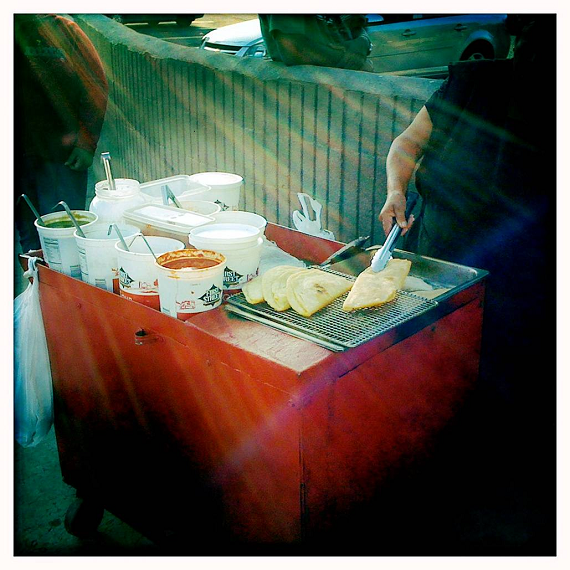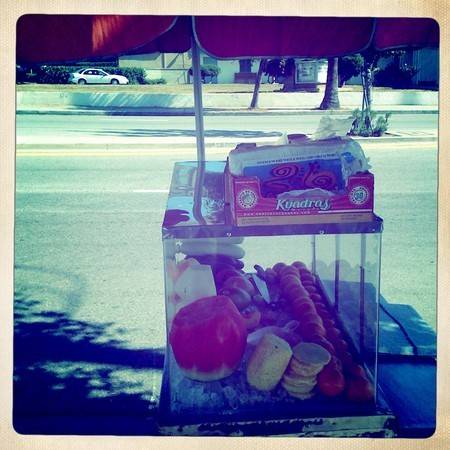Transportation and Food Access Idea 2: Legal and Healthy Street Food
9:26 AM PDT on November 2, 2011
Having written about food & transit last week , I want to share some thoughts (and a poll) on street food. Street and mobile food are important determinants of the food environment in Los Angeles. They are also critical elements of more vibrant streets. But they have enemies and most of the policy activity in the city and region in recent years has been to restrict rather than support street food. I think street advocates should consider whether and how to push in the opposite direction, for legal and healthy street food.
The rules
Street and mobile food are common in the Los Angeles region, especially in low-income, immigrant neighborhoods. Meals, snacks, drinks and groceries are sold from trucks and push carts; from strollers and grocery carts jury-rigged for vending; from grills, tables and tarps temporarily placed along streets and sidewalks; and by vendors carrying food on foot.
Despite its reputation as a hotbed of street food, Los Angeles, is, in fact, the only one of the ten biggest cities in the United States without legal sidewalk vending of food. Los Angeles Municipal Code Section 42(b) prohibits sale of any products, including food, on sidewalks. “No person, except as otherwise permitted by this section, shall on any sidewalk or street offer for sale, solicit the sale of, announce by any means the availability of, or have in his or her possession, control or custody, whether upon his or her person or upon some other animate or inanimate object, any goods, wares or merchandise which the public may purchase at any time.”
Section 42 (m) of the Municipal Code allows for the “Establishment and Regulation of Special Sidewalk Vending Districts.” Complicated regulations, including a requirement that 20 percent of surrounding landowners and residents sign the application in favor of a new district and assignment of vendors to specified, fixed locations make it difficult to establish and maintain vending districts. Only one vending zone, in McArthur Park, was ever created, and it failed.
Food trucks operating in the streets are legal under California Vehicle Code section 22455 but often subject to shifting restrictions on parking. Food trucks and sidewalk vendors are also subject to state and county health codes.
Reasons for the rules
Mobile and street food have been barred or restricted in Los Angeles due to efforts by fixed location stores and restaurants to restrict competition; a narrow definition of what streets and sidewalks are for (unimpeded flow of cars and pedestrians respectively); concerns with food safety; and a ‘suburban’ vision of what a city should look like (a fear of crowds, ethnic diversity, poor people, density etc.) If you are interested in a history of vending, check out Alfonso Morales and Gregg Kettles. “Healthy Food Outside: Farmers Markets, Taco Trucks, and Sidewalk Fruit Vendors. 26 J. Contemp. Health L. & Pol'y 20. Fall 2009; and Anastasia Loukaitou-Sideris and Renia Ehrenfeucht. Sidewalks: Conflict and Negotiation over Public Space. MIT Press, 2009
Scattered enforcement of municipal and County regulations, low entry costs for sidewalk food vendors, and the demand for street food creates an odd juxtaposition in which street food is forbidden but ubiquitous. Vendors themselves are highly visible magnets for activity on the streets, celebrated in popular culture, persecuted by the law, but largely invisible in policy debates about the future of the city.
A snapshot of street vending in South Los Angeles
For our recent project on trasnportation and food access in South Los Angeles with CRA/LA and Esperanza Community Housing Corporation, promatoras from Esperanza interviewed 45 street vendors who were selling food in the project area using every kind of vehicle from improvised push carts to trailors pulled behind cars. Of those interviewed, only 30.2% reported being aware of any laws governing street or mobile vending. 34.9% reported having had encounters with law enforcement in the past. If a legal permit were available, 50% of vendors surveyed said they would pay up to $100 for a permit. 16% of surveyed vendors said they would pay for a permit ‘no matter its cost’. Only 4% said they would not pay for a permit.
Vendors were selling a range of items, with snacks and drinks the most common, but a quarter of vendors sold fruits and vegetables, highlighting the possibility that mobile vending could be a source of healthy food in underserved areas.
Foods Availability by Mobile Vendors
Type of Food | Frequency (%) |
Beverages, bottled | 19 (44.2%) |
Fried foods | 18 (41.9%) |
Snack foods (e.g. chips) | 15 (34.9%) |
Cooked meals (e.g. tacos) | 12 (27.9%) |
Fruit/vegetables, whole | 11 (25.6%) |
Fruit/vegetables, cut | 11 (25.6%) |
Beverages, poured (e.g. horchata) | 7 (16.3%) |
Ice cream/frozen snacks | 6 (14.0%) |
Hot dogs | 4 (9.3%) |
Pre-packaged meal (e.g. sandwich) | 2 (4.7%) |
Changing the Rules
Since most street vendors are interested in being able to sell legally and because street food should be a valued part of a diverse and healthy city, it’s worth considering some models for changing the law to allow food to be sold on sidewalks in the City of Los Angeles. I’ll summarize four options: a legalize and regulate model; a greencarts model, a private land model, and a ‘benign neglect’ model.
- Legalize sidewalk vending and support and regulate mobile food vending. The City of Los Angeles should allow permitted sale of food on city sidewalks. A legal permitting process would recognize the value of street and mobile vending, create opportunities for entrepreneurship in the legal economy, and allow the City to regulate and influence street food to make it healthier. This option, which is the recommendation of our food and transportation in South LA project, would have a few components:
- Legalize sidewalk vending - without onerous and expensive requirements. The more restrictions that are placed on vendors such as limits on where they can operate, needing permission from adjacent stores/ restaurants, mandatory dimensions or aesthetics for carts, etc, the harder it will be for vendors to afford or comply with permits. There are some specific recommendations on the what/ where / who/ how of sidewalk vending on pages 22-23 of our food and transportation report. Los Angeles County Department of Public Health will have to be actively engaged in figuring out ways to make health regulations easy to understand and to comply with.
- Incentivize vending of healthy items. The City should use incentives and disincentives to encourage more vending of healthy items by produce trucks, food carts and other mobile vendors. The mobile food task force of the Los Angeles Food Policy Council is working on a point system for rating vended food that could be the basis for definitions of healthfulness. Incentives could include lower price permits for vendors of healthier items, priority access to private or public sector loans/ grants, permission to sell at a broader range of zones or priority in receiving permits to sell at desirable spots, waiver of requirements to store carts at commissaries, etc.
- Maintain and enforce restrictions on unhealthy vending near schools. With LAUSD improving the nutrition of school food, vendors of junk food and snacks setting up near school campuses have become a major source of bad food for students. To support schools as healthy places to learn and oases from the junk and fast food that characterize many neighborhoods, the City should maintain and enforce a ban on unhealthy food vending near schools.
- Legalize ‘green carts’ that sell only healthy food. An alternative to legalizing vending of all food on sidelwalks is to just legalize the sale of healthy items. Cities such as New York have created a separate class of green cart vending permits for sales of fruits and vegetables.l Los Angeles County is exploring whether they can start a pilot project of green carts in unincorproated regions of the County.
- Focus on privately owned space near sidewalks as sites for vending. In some cities like Portland, Oregon (where it is legal to sell on sidewalks), most food carts are located on privately owned lots just off the sidewalks. http://www.foodcartsportland.com/maps/ If it proves too difficult to legalize or regulate sales of food on sidewalks in Los Angeles, a fall back position could be to ensure that zoning laws governing private land allow siting of food carts and sales of food.
- Encourage regulators to treat healthy street food with ‘benign neglect.’ Advocates for health could work with vendors and regulators so that policie and health inspectors do not target sellers of fruits, vegetables, and healthy meals. There is some evidence that current enforcement already follows this pattern, with hotdog vendors more likely to be sited than sellers of cut fruit.
Stay in touch
Sign up for our free newsletter
More from Streetsblog Los Angeles
Metro Board Funds Free Student Transit Pass Program through July 2025
Metro student free passes funded another year - plus other updates from today's Metro board meeting
Eyes on the Street: New Lincoln Park Avenue Bike Lanes
The recently installed 1.25-mile long bikeway spans Lincoln Park Avenue, Flora Avenue, and Sierra Street - it's arguably the first new bike facility of the Measure HLA era






